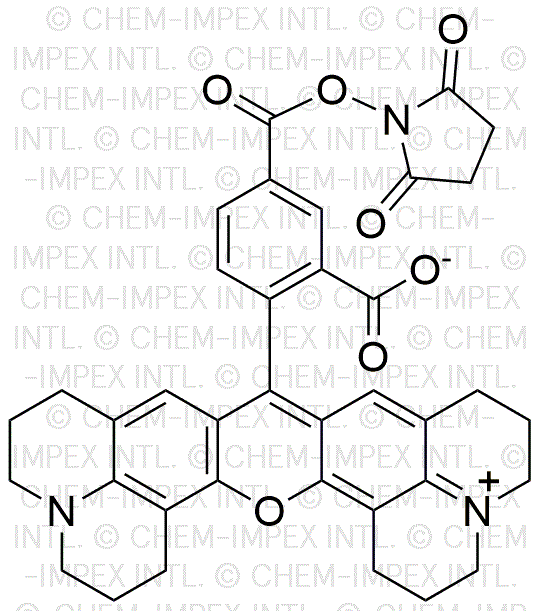5-Carboxy-X-rhodamine N-succinimidyl ester is widely utilized in research focused on:
- Fluorescent Labeling: This compound is commonly used for labeling biomolecules in fluorescence microscopy, allowing researchers to visualize cellular structures and processes with high specificity and sensitivity.
- Bioconjugation: It serves as an effective tool for bioconjugation, where it can be attached to proteins or antibodies, enhancing their detection and tracking in various biological assays.
- Diagnostics: In the field of diagnostics, it is employed in the development of assays for detecting specific proteins or nucleic acids, improving the accuracy and reliability of test results.
- Drug Development: The compound is utilized in drug development research to study drug interactions with cellular components, aiding in the design of more effective therapeutic agents.
- Environmental Monitoring: It is also applied in environmental science for tracking pollutants and studying their effects on ecosystems, providing valuable data for regulatory compliance and environmental protection.
General Information
Properties
Safety and Regulations
Applications
5-Carboxy-X-rhodamine N-succinimidyl ester is widely utilized in research focused on:
- Fluorescent Labeling: This compound is commonly used for labeling biomolecules in fluorescence microscopy, allowing researchers to visualize cellular structures and processes with high specificity and sensitivity.
- Bioconjugation: It serves as an effective tool for bioconjugation, where it can be attached to proteins or antibodies, enhancing their detection and tracking in various biological assays.
- Diagnostics: In the field of diagnostics, it is employed in the development of assays for detecting specific proteins or nucleic acids, improving the accuracy and reliability of test results.
- Drug Development: The compound is utilized in drug development research to study drug interactions with cellular components, aiding in the design of more effective therapeutic agents.
- Environmental Monitoring: It is also applied in environmental science for tracking pollutants and studying their effects on ecosystems, providing valuable data for regulatory compliance and environmental protection.
Documents
Safety Data Sheets (SDS)
The SDS provides comprehensive safety information on handling, storage, and disposal of the product.
Product Specification (PS)
The PS provides a comprehensive breakdown of the product’s properties, including chemical composition, physical state, purity, and storage requirements. It also details acceptable quality ranges and the product's intended applications.
Certificates of Analysis (COA)
Search for Certificates of Analysis (COA) by entering the products Lot Number. Lot and Batch Numbers can be found on a product’s label following the words ‘Lot’ or ‘Batch’.
*Catalog Number
*Lot Number
Certificates Of Origin (COO)
This COO confirms the country where the product was manufactured, and also details the materials and components used in it and whether it is derived from natural, synthetic, or other specific sources. This certificate may be required for customs, trade, and regulatory compliance.
*Catalog Number
*Lot Number
Safety Data Sheets (SDS)
The SDS provides comprehensive safety information on handling, storage, and disposal of the product.
DownloadProduct Specification (PS)
The PS provides a comprehensive breakdown of the product’s properties, including chemical composition, physical state, purity, and storage requirements. It also details acceptable quality ranges and the product's intended applications.
DownloadCertificates of Analysis (COA)
Search for Certificates of Analysis (COA) by entering the products Lot Number. Lot and Batch Numbers can be found on a product’s label following the words ‘Lot’ or ‘Batch’.
*Catalog Number
*Lot Number
Certificates Of Origin (COO)
This COO confirms the country where the product was manufactured, and also details the materials and components used in it and whether it is derived from natural, synthetic, or other specific sources. This certificate may be required for customs, trade, and regulatory compliance.


